By Jean Llewellyn (with grateful thanks to Ed Balcewich and Jeff From)
Photography: Private collection, Neil Carleton, FEI/Shannon Brinkman
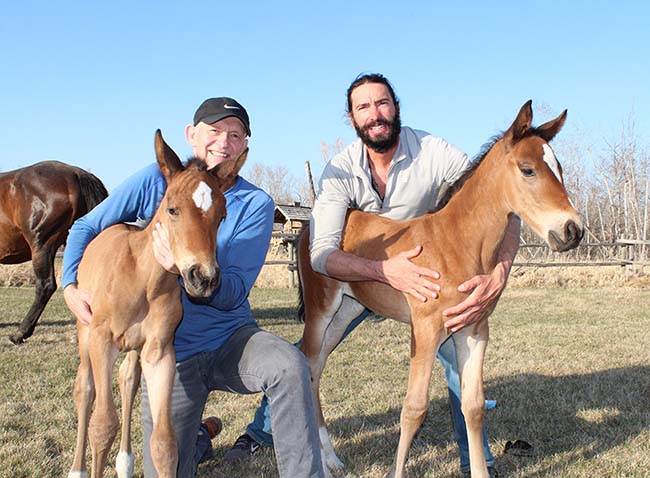
As sport horse breeding partners, Ed Balcewich, from Winnipeg, and Jeff From who lives in St. Andrews, both in the Canadian province of Manitoba, are one of the most unlikely combinations. Jeff, an experienced horseman, farrier, competitive showjumper, and breeder, and Ed, a portfolio manager with no horse experience, acquired his first horse that happened to be the jumping stallion, Grama Open Main. What a surprise, therefore, when their first attempt at breeding from three mares produced four foals.
Their twin Selle Français fillies went to full term, were both full size, and 100% healthy on the day of their birth: April 28, at 6:30 a.m. They arrived complete with a great pedigree.
When it was all over, Jeff admitted; “We were in shock to see two babies being born.” Their mare, Zena QV, had been on 24-hour watch as she had gotten really large, and when she finally laid down Jeff was there to monitor the birth. However, he was soon on the phone with the vet when a third hoof showed up, believing that the foal’s back leg was in an awkward position and therefore needed to be pushed back to adjust it, only to find another head and another hoof trying to get out. The slightly larger foal arrived first, with the second following quickly behind with no complications.
Zena QV had already produced two previous foals by Grama Open Main who are now six and seven years old, so the partners knew that any resulting foal from this crossing would be an athletic jumper with lots of scope, a sound mind and willing disposition, just like its sisters. Ed admitted; “Zena QV got big, then she got bigger, and we nervously joked that it could be twins, yet we all knew that was hardly feasible because the odds of twins surviving was worse than one in a million.”
Since they were born they’ve generated a great deal of interest from curious clients, family, friends, veterinarians, and experienced horse people, who had never heard of live twins before. Not only are these twin fillies special as survivors, but they were intentionally bred to carry showjumping royalty in their genetics, as full sisters to Sapphire and Geneva.
Inspired by Beezie Madden and Darry Lou
It was nearly two years ago, at the 2019 Spruce Meadows Masters, when Jeff completed two nice rounds on Grama Open Main in the All Canada Ring and Ed recalls; “We had front-row seats (in the international ring) for the $3 million CP International Grand Prix where we watched Beezie Madden win with Darry Lou, and it perked my curiosity as to the make-up of modern jumping bloodlines. They certainly don’t come any more modern than Darry Lou, and looking over his pedigree we realized we could just as easily be looking at Jeff’s horse, Sapphire, a big, beautiful, and powerful athlete who would be old enough and ready to compete during the Spruce Meadows 2020 tournament season.
It was Jeff’s decision some years earlier to breed Grama Open Main (Hello du Reverdy x Voltaire) to Zena QV (Quite Easy x Burggraaf) two years in row to produce Sapphire and Geneva. “They turned out beautifully and are everything that a high-level showjumper should be, so breeding them again was a no brainer.”
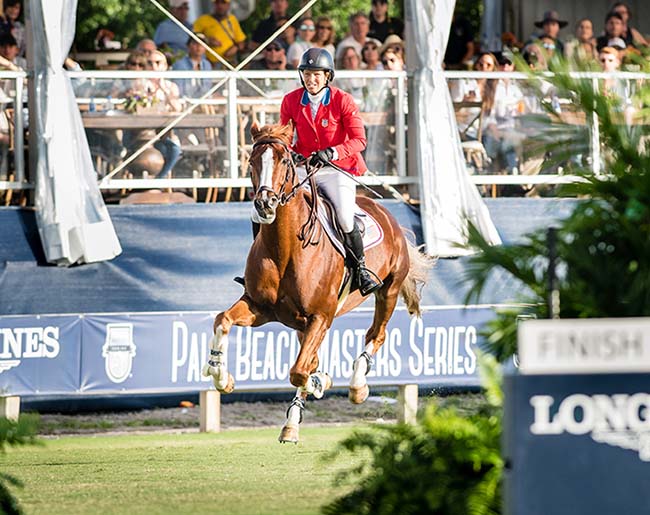
Common Ibrahim sire lines
Ed continued by saying: “At first glance, Darry Lou (Tangelo van de Zuuthoeve x Nabab de Reve) and the twins (Grama Open Main x Quite Easy) don’t look similar, yet when we dig a little deeper into their pedigrees, the commonalities are uncanny. On the sire’s side both Darry Lou and the twins come from a ‘tail sire line’ of Ibrahim in the fifth generation as well as both having four gender-balanced crosses of Ibrahim and two of Almé Z: Founding stallions of the Selle Francais breed, even though Almé Z is the son of Ibrahim. Looking at the names of recent FEI winners, these two frequently occur.”
Genetically identical damline ‘engine rooms’
“Here is where it gets interesting. When we explored their pedigrees further, we found that in the engine room – being the fourth to sixth generations – their damlines are almost identical, with so many big-name ancestors occurring in the same places on their damlines: Names such as Burggraaf and Quidam de Revel in the third generation; Jalisco B and Landgraf in the fourth; Ibrahim, Almé Z, Ladykiller xx, and Cor de la Bryère in the fifth, and of course more of the same in the sixth.
“At that time I contacted Kathleen Kirsan, author of a number of breeding and bloodline books, including North American Sport Horse Breeder and Become Your Own Tesio (https://www.sport-horse-breeder.com). We had many online conversations about breeding in general as well as breeding stallions specific to Jeff’s herd.
“Kathleen had reviewed Sapphire’s (and the twin’s pedigree) and said, ‘Zena (Sapphire’s mother) has the power-gender balance of Landgraf close up, jumping potency guaranteed, and Sapphire is genetically the best, with the strongest Ramiro and Landgraf balance, and she carries something we don't see often: a Corde daughter. Well done. [...] This is serious jumping genetics [...]’.
“Jeff, being a lifelong, experienced horseman, has a good instinct for breeding quality sport horses. In fact, he used Grama Open Main some 18 times over the years and produced beautiful offspring, of which almost all are competitive showjumpers. It’s not uncommon to go to a Hunter/Jumper competition in Manitoba and see four or five of his offspring in the same show ring, and doing very well.”
Much of the knowledge that Ed gained was from the online conversations with Kirsan and from her books. His professional background as a stock trader and portfolio manager proved valuable as he was familiar with assessing large amounts of data, graphs, and charts. So reviewing generations of pedigrees, bloodlines, and common ancestors made for interesting reading during the Covid-19 lockdown days of Spring 2020 in rural Manitoba.
With subscriptions to online databases Ed created hypothetical matings for hours, looking at influential combinations of potency, pedigree, and gender balance. When he found a superior match with Zena QV and her daughters, Ed would shop to see if any frozen semen was available, and there was plenty, which supported Tesio’s theories of the importance of his mares. “In fact, I was gaining an all-round better understanding of the Tesio method which indicates that the mare is far more important than the stallion. A poor stallion to a quality mare generally produces much better offspring than a great stallion to a poor mare, hence quality to quality produces the best results, on paper.”
Interestingly, Ed discovered that shopping for frozen semen is almost as easy as buying products on Amazon, but the mares are much harder to identify and purchase, especially if she is a genetic gem. “Jeff jokes that from his herd of all mares he has been unable to produce a colt in 13 years. To Jeff’s credit, this is how Federico Tesio operated, with a herd of only genetically rich mares, without owning a stallion himself.
“We do differ from Tesio, however, as we have a stallion Grama Open Main (affectionately nicknamed Chachi),” and while Ed has only owned him for four years, Jeff has a long friendship and history with the stallion dating back to 2010 when he was imported from Argentina. “Chachi is a great horse to ride and knows what it is to work. The fine character he has in the sport, he passes on to his progeny. Of course, he inherited these traits from his own ancestors as they are well known for their power, work ethic, and calm, easy-going personalities.”
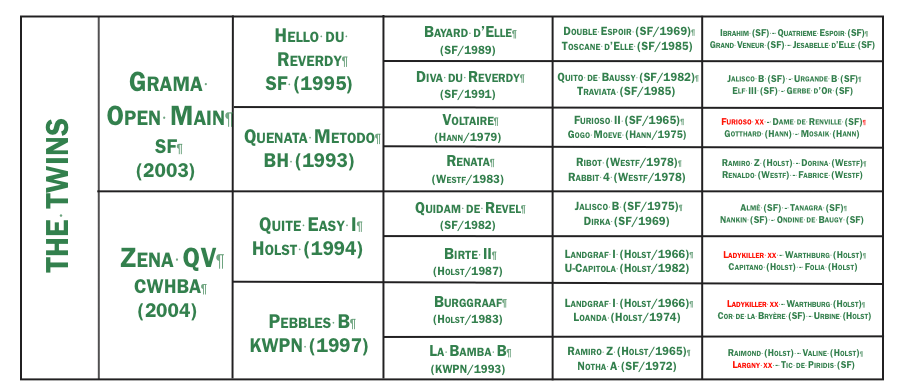
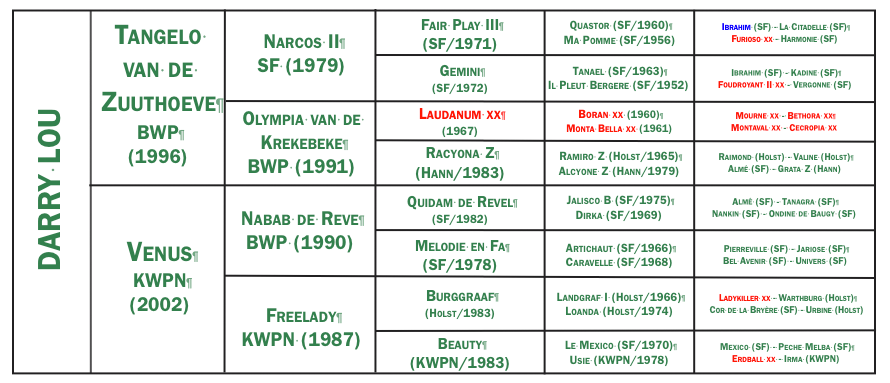
Breeding jumpers with powerful pedigrees
Ed continued; “We reviewed research into the pedigrees of the world’s top 300 showjumpers, showing that 99% of these horses have no line-breeding in the first two generations. As we are only breeding showjumpers we are generally not concerned with the first three generations, but rather the ‘engine room’, being the fourth, fifth, and sixth generations where the true power of line-breeding provides us with a much higher chance of developing an exceptional showjumping horse. This helps explain why we can see a successful showjumper with the blood of insignificant stallions in the first three generations as they serve as a conduit for the DNA from the different lines of more powerful ancestors.
“According to an excerpt in Kathleen Kirsan’s latest book, Be Your Own Tesio, ‘The aim is not to simply pump in as much duplication as can be found. The aim always is to maximize the probability. This is done by first building up a large mass of genetic commonality in the sixth to twelfth, and then having lines in the fourth, fifth, and sixth generations which have inbreeding to the pattern of strength further back’.”
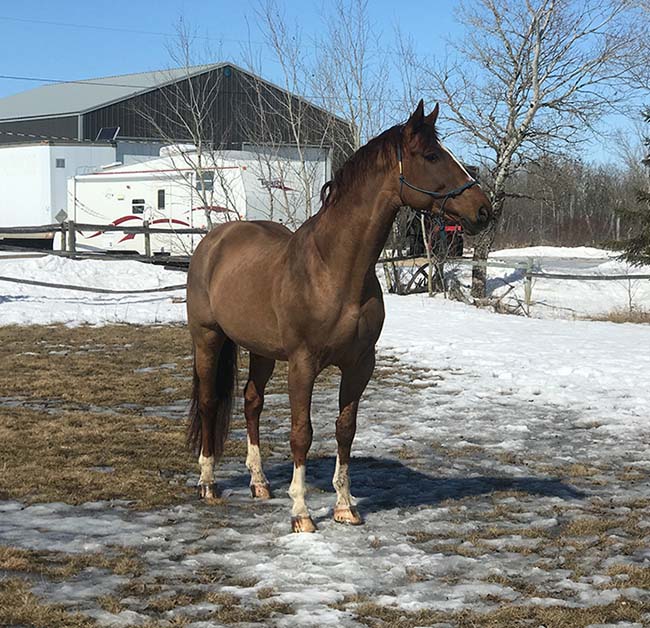
Sharing common ancestors
According to Ed, Kirsan commented on the twins’ pedigree as follows; ‘These bloodlines are a who’s who of the European jumping horse [...] and you made the most of those jump conduits by picking mares that enlarge the power, and now you know you had it right.’
“Tesio painstakingly did everything by handwriting the lineages. Now, with a click of the mouse we can look back over one-hundred years and see that both the Darry Lou and the twins’ lines carry multiple crosses of influential ancestors. The list is too numerous, and you would have to Google the names to get a true picture of their power and lineage, however, here are few examples as to what a great pedigree looks like in the first nine generations of line breeding.
• Orange Peel: Darry Lou = 11 crosses, the twins = 16 crosses – ‘[...] great influence on the breeding of showjumpers’
• Son In Law: Darry Lou = 11 crosses, the twins = 11 crosses – ‘[...] seen in the pedigree of the top 100 showjumpers’
• Dark Ronald: Darry Lou = 11 crosses, the twins = 12 crosses – ‘Cor de la Bryère, Lord, and Landgraf I were all linebred to him,’ enough said;
• The Tetrarch: Darry Lou = 10 crosses, the twins = 6 crosses – an undefeated racehorse with freakish speed and power, he is ‘possibly the greatest runner ever’. Because he was too fast and too strong, The Tetrarch, a potent jump transmitter, is not found in many pedigrees. Consider yourself lucky if you have him in your pedigree.
A happy future...
Ed concluded the story by saying; “Immediately after the Spruce Meadows Masters, Darry Lou was sold to Evergate Stables, owned by Jennifer Gates, in Wellington, Florida for an undisclosed amount, although it was likely a substantial sum. (Editor’s note: Darry Lou was only ridden for a few months by Jennifer Gates, and has since January 2021 been ridden by her fiancé, US-born, Egyptian international showjumper Nayel Nassar.)
“Whether the twins turn out to be great showjumpers like Darry Lou, or will perhaps continue their genetic lines as conduits for the DNA of their ancestors, they will always get to live a wonderful life as horses on Jeff’s equine acreage on the Manitoba prairies. Regardless, they are part of his herd of mares who carry powerful jumping genetics for the future of the sport. We are thankful for the one-in-a-million chance that was given to us to have the twins. We are especially thankful to the mare, Zena QV ‘super mom’ for carrying the babies to full term, as we could see that she was experiencing discomfort in carrying such a precious load.
“Coincidentally, Jeff finally got his colt with the last 2021 foal.”
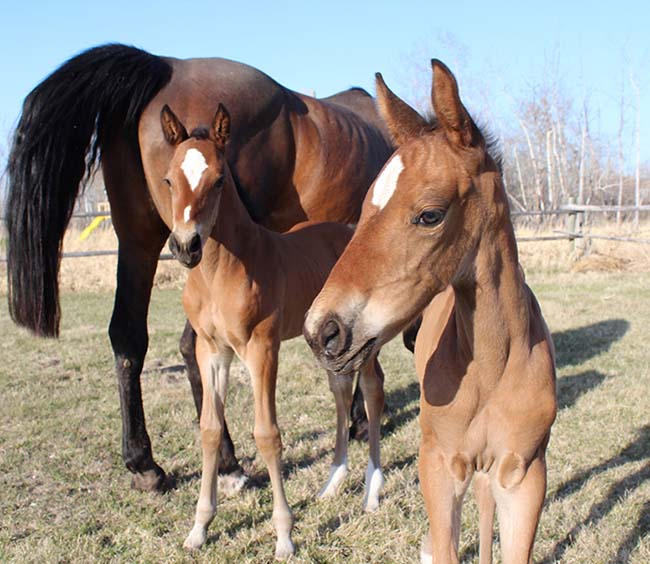
As a prequel to this story, Ed Balcewich explained that he and Jeff met in June 2019 quite by chance. Both Zena QV and Grama Open Main ‘Chachi’ were ‘back burner’ horses for whom their owners had no time. “I found Grama Open Main in a barn – three years in a stall, then two years at pasture, doing nothing during his prime. Five years out of showjumping, and he competed at the Spruce Meadows Masters with just 12 weeks of training.
“Jeff purchased Zena QV from a friend who had no time for training. He decided to use her as a broodmare with a few different stallions – Grama Open Main, Vision van Hazelarenhoekje (Clinton x Quite Easy), and Far West (Muguet du Manoir x Quite Easy) – establishing a remarkable herd of mares with great jumping genetics.”
Grama Open Main was imported from Argentina in 2010, when his then owner gave him to Jeff (from the age of seven to 11) to train, ride, and use for breeding. They were a winning combination in the ring, moving up from 1m30 to 1m50, and the stallion produced around 15 successfully competing progeny. Sadly, in 2014 Chachi’s owner removed him from Jeff’s care and he spent three years in a barn, which was when Ed found him, saying; “His friendly, funny character attracted me to visit him every time I went with my daughter to ride at the same barn. I spent more time with him than watching anyone ride as he has an infectious personality. After purchasing him in 2017, we moved him to Eastern Manitobe where he got lots of exercise on an acreage, which he loved. After two years we realized he needed more than we could offer, so I contacted a number of showjumping trainers.”
Ed and his daughter, Ainsley, reconnected Jeff with Chachi in June 2019 when they resumed showjumping. Jeff said: “I got my best friend back,” as Chachi was literally jumping for joy when he heard Jeff’s voice again for the first time. Luckily, Chachi still had all his ‘buttons’, quickly recovered his fitness, and the pair progressed. “While Chachi hadn’t jumped in five years, it was clear that he was happy to have a purpose and a job again.” He and Jeff went to the Spruce Meadows Masters in 2019, completing two nice rounds. According to Ed; “While he didn’t place, he didn’t look out of place.”
It was at this time that Jeff and Ed were inspired to have more conversations about breeding and, since then, Ed has promised that Chachi would always remain at Jeff’s farm, as it’s where he’ll enjoy the best possible life, as well as a hopeful return to the showjumping circuit post Covid-19. J.L.
